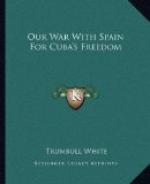The meeting between Colonel Astor and Major Irles was extremely courteous, but very formal, and no attempt was made by either of them to discuss anything but the matter in hand. Major Irles was given his choice of three Spanish lieutenants in exchange for Hobson, and was also informed that he could have all of the fourteen men in exchange for the American sailors. The Spanish officers selected Lieutenant Aries, and the other two Spanish officers were conducted back to Juragua.
It was then not later than 4 o’clock, and just as everything was finished and the two parties were separating Irles turned and said, courteously enough, but in a tone which indicated considerable defiance and gave his hearers the impression that he desired hostilities to be renewed at once:
“Our understanding is, gentlemen, that this truce comes to an end at 5 o’clock.”
Colonel Astor looked at his watch, bowed to the Spanish officer, without making a reply, and then started back slowly to the American lines, with Hobson and his companions following.
The meeting of the two parties and the exchange of prisoners had taken place in full view of both the American and Spanish soldiers who were intrenched near the meeting place, and the keenest interest was taken in the episode.
Santiago under fire.
On the morning of June 6 the American fleet engaged the Spanish batteries defending the entrance of the harbor of Santiago de Cuba, and, after three hours’ bombardment, silenced nearly all the forts, destroyed several earthworks, and rendered the Estrella and Cayo batteries, two of the principal fortifications, useless.
The fleet formed in double column, six miles off Morro Castle, at 6 o’clock in the morning, and steamed slowly 3,000 yards off shore, the Brooklyn leading, followed by the Marblehead, Texas and Massachusetts, and turned westward. The second line, the New York leading, with the New Orleans, Yankee, Iowa and Oregon following, turned eastward.
The Vixen and Suwanee were far out on the left flank, watching the riflemen on shore. The Dolphin and Porter did similar duty on the right flank. The line headed by the New York attacked the new earthworks near Morro Castle. The Brooklyn column took up a station opposite the Estrella and Catalina batteries and the new earthworks along the shore.
The Spanish batteries remained silent. It is doubtful whether the Spaniards were able to determine the character of the movement, owing to the dense fog and heavy rain which were the weather features this morning.
Suddenly the Iowa fired a twelve-inch shell, which struck the base of Estrella battery and tore up the works. Instantly firing began from both Rear-Admiral Sampson’s and Commodore Schley’s column, and a torrent of shells from the ships fell upon the Spanish works. The Spaniards replied promptly, but their artillery work was of a poor quality and most of their shots went wild. Smoke settled around the ships in dense clouds, rendering accurate aiming difficult. There was no maneuvering of the fleet, the ships remaining at their original stations, firing steadily. The squadrons were so close in shore that it was difficult for the American gunners to reach the batteries on the hilltops, but their firing was excellent.




